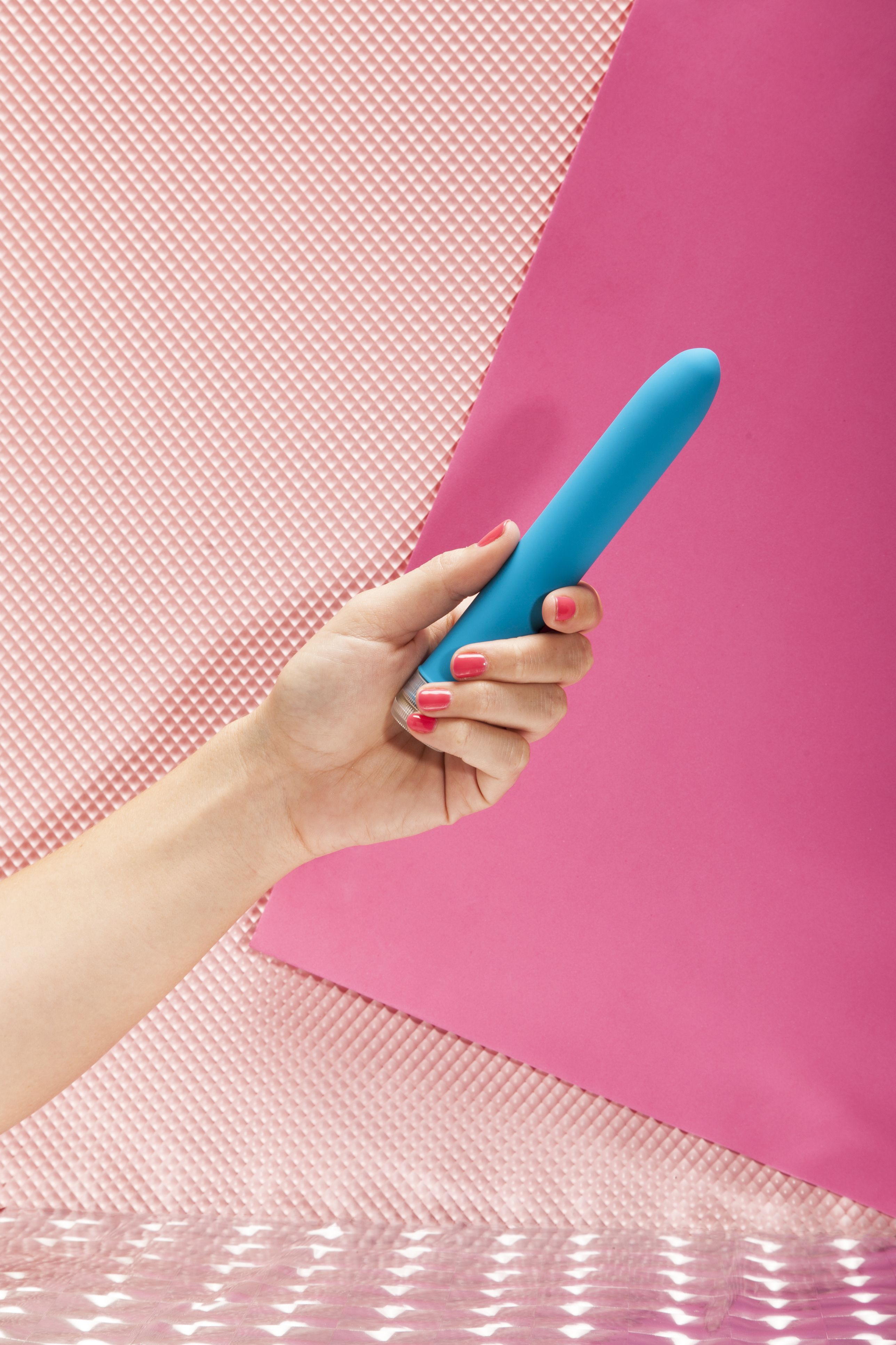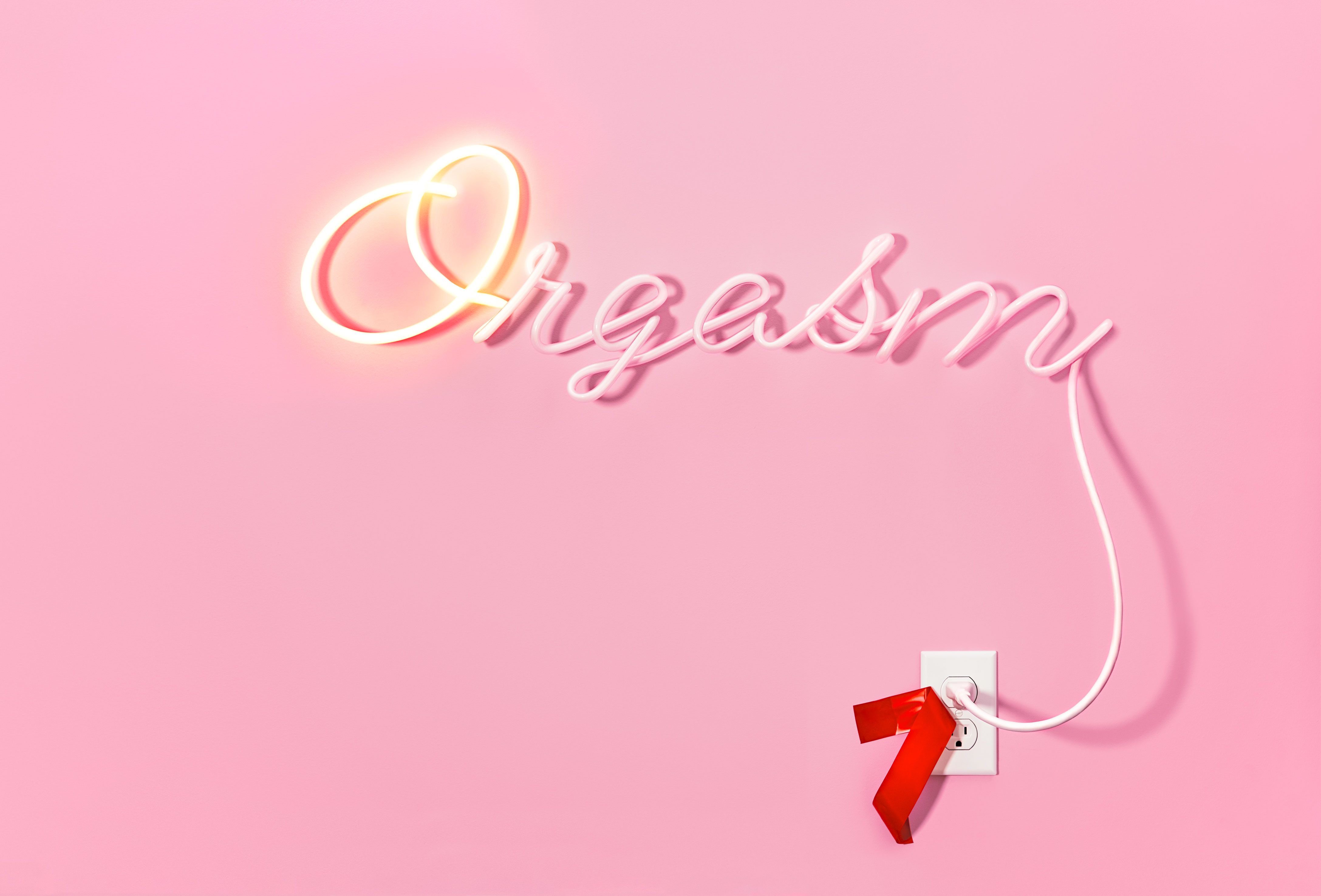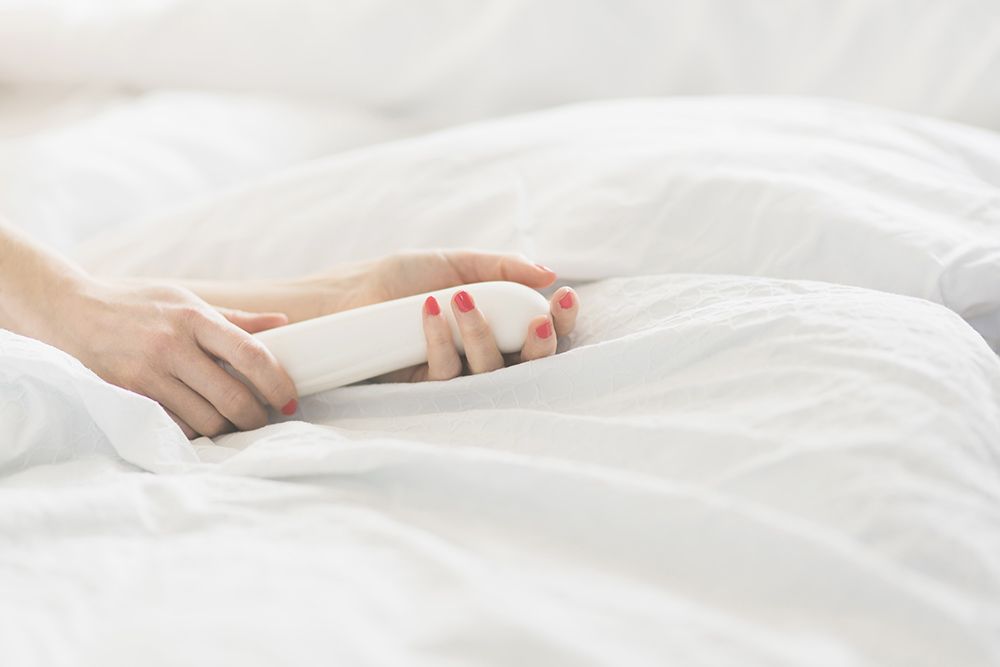
The big O can boost your mood, help you sleep better, strengthen your immune system, improve your relationship, and more. But it makes everyone—and we mean everyone (doctors, universities, government agencies)—flinch. WH investigates why women are getting the short end of the stick when it comes to getting off, and talks to the brave ladies who are cutting through the red tape, so you can.
Lora Haddock figured her company might be controversial in some circles. After all, she was starting a woman-oriented pleasure-tech company and designing a sex toy that mimicked all the motions of a human partner. Better still, the gadget stimulated the clitoris and vagina simultaneously, without needing a hand to hold it in place.
But Haddock thought the tech world was ready for a product that was part robot, part vibrator, and all about a woman’s sexual pleasure. The Osé (pronounced oh-SAY) that Haddock designed as the head of her company, Lora DiCarlo, had 52 complex engineering requirements, as well as a slew of patents pending before it hit the market. Haddock knew the Osé was something special—and groundbreaking—because it used the latest technology to give women what they want.
The Consumer Electronics Show (CES) thought so too, notifying Haddock last fall that it would be awarding the Osé its 2019 Robotics & Drones Innovation Award. But before the ink had dried on the notice of their honor, the CES revoked its award. “Our jaws hit the floor,” Haddock says.
In a letter Haddock shared with WH, CES quoted terms buried deep in the small print: “Entries deemed by CTA [Consumer Technology Association, the organization behind the annual CES show] in their sole discretion to be immoral, obscene, indecent, profane, or not in keeping with CTA’s image will be disqualified.” Never mind, of course, that current and past exhibitors had demoed augmented reality porn and a robot sex doll that can give blow jobs.
“There’s an overvaluing of male sexual pleasure and a devaluing of female sexual pleasure.”
The double standard struck a nerve, and Haddock fired back with an open letter to CES, writing, “You cannot pretend to be unbiased if you allow a sex robot for men but not a vagina-focused equivalent.” In other words, the organization was okay with helping a guy get his rocks off, but not a woman. The implied message was that women’s sexual health is not worthy of innovation.
Months passed after that slap in the face. Then, fortunately, CES reinstated Haddock’s award in May 2019, right before this story went to press, stating that “CTA recognizes the innovative technology that went into the development of Osé and reiterates its sincere apology to the Lora DiCarlo team.”
As this debacle shows, in our boner-centric culture, female orgasm still remains taboo. Climaxing is all well and good if it gives a man another notch on his belt, but when a female-identifying individual has an orgasm for the sake of an orgasm, people start to squirm (and not in a good way).



“There’s an overvaluing of male sexual pleasure and a devaluing of female sexual pleasure,” says Laurie Mintz, PhD, a professor of psychology at the University of Florida and the author of Becoming Cliterate: Why Orgasm Equality Matters—And How to Get It. And this imbalance, more than anything else, is helping to drive what researchers call the orgasm gap. A large survey of American adults found that nearly 95 percent of men had an orgasm during their last sexual encounter, but only two-thirds of women did.
It’s likely that gap only gets wider when sex happens outside of a committed relationship, because in those circumstances men may not feel the need to reciprocate pleasure, and women may not know how to approach the topic. The impact is felt far outside the bedroom. Missing out on orgasm means not only that you’re unable to enjoy its health benefits, such as better mood, deeper sleep, relief from headaches, and glowing skin, but also that you’re missing out on a fundamental human experience that’s fun to boot.
Well, that blows (for lack of a better term). There’s a lot to unpack here, and it’s a twisted tale of gender-biased hookup culture, poor research funding, hypocritical subway advertising rules (we’ll get to those later), and oh-so-much more. But the promising news is that women are fighting back and taking charge of their bodies and their sex lives—for good.
Pleasure 101
It starts as early as our first class in sex ed. We learn the names and functions of the different genitals, and, if we’re lucky, we learn about more than just abstinence, including how to prevent pregnancy and STDs. There are periods and body hair, and that’s about it. One of the many things missing? Pleasure, especially for her.
 Jamie Chung for Women’s Health
Jamie Chung for Women’s Health
It’s no surprise, then, that in a survey of college women, nearly 30 percent could not identify the proper location of the clitoris. Alison Ash, PhD, a sex and relationship expert in San Francisco, says it’s not just a lack of proper sex ed that’s causing this ignorance. “Scientists didn’t discover the full anatomy of the clitoris until 1998—decades after they put a man on the moon,” she says. So the results of being sidelined become apparent as soon as women start having sex.
As a doctoral student in sociology at Stanford, Ash studied heterosexual hookup culture and found that “a lot of women don’t know what they want or how to ask for it,” she says. “Women are prioritizing what they think is their partner’s well-being over their own pleasure.”
Her data revealed that hookups were focused on him. Only 11 percent of women experienced climax the first time with a new partner, although the percentage increased in long-term relationships. Researchers from Indiana University analyzed data from the National Survey of Sexual Health and Behavior, with a pool of 1,931 adults in the U.S. ages 18 to 59, and found that this gap wasn’t just a youth phenomenon—it was happening at all ages. Men are 27 percent more likely to report having an orgasm than women during a sexual encounter, found research published in the Journal of Sexual Medicine.
“You have to figure out what you like, then you have to be brave enough to ask for it.”
What’s more, in many heterosexual relationships, a woman’s orgasm is seen as a reflection not of her desire and satisfaction but of her partner’s sexual prowess and masculinity, according to a study in the Journal of Sex Research. It’s partly why 67 percent of women have faked an orgasm with a partner, compared with just 28 percent of men: Heterosexual women know that what’s at stake is not so much our own pleasure, but his ego.
Although it’s easier for people with penises to be sure they’ve climaxed because they release semen, another factor is that women understand so much less about what they want and what brings them pleasure. And that’s a major problem. Not only do orgasms boost immunity and help combat stress (yes, please!), but the chemical release actually helps partners bond. Fibbing about the big O or avoiding it altogether? It might be easier in the short term to avoid asserting your needs in bed, but over time, couples lose a valuable opportunity to communicate.
“You have to figure out what you like, then you have to be brave enough to ask for it specifically, and ask and ask again until your partner gets it right,” says sex therapist Aline Zoldbrod, PhD.
Paging Dr. Orgasm…
Hello? Is anybody there? With so much cultural and medical ignorance around female orgasms, you might think funding agencies would be willing to support scientists who are studying the problem. You’d be wrong.
Despite 43 percent of women reporting some type of sexual dysfunction, research on women and orgasms is shockingly sparse—or nonexistent. The National Institutes of Health funded no research over the past decade specifically devoted to improving women’s orgasms, according to a WH analysis of NIH grants.
 Jamie Chung for Women’s Health
Jamie Chung for Women’s Health
Female researchers are feeling this discrepancy firsthand. As a junior faculty member at UCLA, neurophysiologist Nicole Prause, PhD, says the university ethics board refused to let her conduct experiments measuring the physiological responses of couples having sex in the lab without providing her with specific objections about why the research was blocked.
After a decade of trying to make it in academia, this obstacle was the last straw. Prause finally gave up and founded Liberos, an independent sex research institute in Los Angeles, to continue her work around sexual pleasure. (When contacted, a UCLA rep responded that “out of respect for all employees and consistent with university policy, we do not discuss circumstances surrounding change of employment status.”)
Blunt without being rude, Prause urges her colleagues to take female pleasure seriously and bring more rigor to their work. At a recent conference, she attended a session where researchers asked study participants to eat chocolate in order to measure pleasure.
“I asked why they didn’t have the participants stimulate their own genitals. And they looked at me like I was an alien,” she says. Prause points out that the general public is eager for this type of research. She never has problems recruiting participants for her studies. When she recently placed an ad on Craigslist for one, she had more than 400 calls and emails within 30 minutes. “Orgasm is safe, free, and accessible; why wouldn’t we want to fund research about it?” Prause asks.



University of Michigan bioengineering PhD student Lauren Zimmerman, 25, knows this problem all too well. Her lab at the university is devoted to the stimulation of nerves in the lower leg and near the genitalia for treatment of overactive bladder. What piqued Zimmerman’s interest was when she learned that stimulating these same nerves might also help women who couldn’t achieve orgasm. She received funding for a small pilot trial to see if small amounts of painless electrical stimulation on the tibial nerve in the ankle and a nerve near the clitoris could improve women’s ability to climax, but she ran into difficulties securing funding for follow-up research. When she talked with officials about her project, they seemed interested. “When it came time for decisions, it never seemed to fall in my favor,” Zimmerman says.
Clinical psychologist Erin Cooper, PhD, says this is par for the course among sex researchers. “We’re trying to understand the female orgasm, more than ever. But there simply isn’t much money going toward this research.”
After rounds of applications, Zimmerman found funds that would provide financial support for her as a scientist rather than for her specific project. She easily recruited participants and discovered that 12 weekly stimulation sessions could improve a woman’s ability to reach orgasm. But when she presented those results at one scientific conference, she says she was laughed out of the room. “They thought it was a dirty joke and not a real clinical need,” Zimmerman says.
Saying yes to feeling good
Entrepreneur Polly Rodriguez, 32, learned the hard way how lightly female desire is taken. When radiation treatment for stage III colon cancer sent the then 21-year-old into menopause, doctors told her she would never be able to have children but failed to mention that her sex drive and ability to enjoy sex could be affected.
It was only thanks to some online searching that she finally figured it out. (The places Rodriguez could find that sold vibrators in her rural corner of the Midwest felt far too seedy for her to ask intimate questions about climax.) To fill the void, Rodriguez launched Unbound in December 2014, an online marketplace providing a sex-positive space for women to share experiences and find products that meet their sexual needs, ranging from lube and vibrators to handcuffs. “Men have had Playboy and Viagra, and I want those kinds of brands to exist for women,” Rodriguez says.
“Orgasm is safe, free, and accessible; why wouldn’t we want to fund research about it?”
Though her company’s growth has surpassed her wildest dreams, with more than 200,000 unique hits per month, Rodriguez built her brand without advertising on social media or public transit. Facebook’s policies allow only the advertisement of condoms as family planning aids or to prevent STIs; for vibrators, forget it. When Rodriguez pushed back against this prudish policy, a representative wrote her that advertising for adult products and services wasn’t allowed.
The explanation? “This is driven by an understanding of people’s sentiment for these ads,” the email read. (When reached for comment, a Facebook spokesperson responded with the following: “We have long had a policy that restricts certain ads with adult content and adult products in part because Facebook is a global company and we take into account the wide array of people from varying cultures and countries who see them…As with all of our policies, our enforcement is never perfect but we are always improving.”)


And New York City’s Metropolitan Transit Authority refused to post an ad for Unbound, calling it “phallic,” despite Rodriguez’s efforts to show fully clothed women of various races with nary a penis in sight. According to Rodriguez, the same day she was rejected, the MTA green-lit ads for a company selling male sexual enhancement products that portrayed a limp cactus and a perky cactus—far more phallic than Unbound’s ads. (The MTA did not respond when asked for a statement.)
Where do we ‘O’ from here?
Despite these roadblocks, the breakneck pace of Unbound’s expansion and the buzz around—and ultimate recognition of—products like the Osé show that another sexual revolution is underway.
Women are tired of putting their desires on the back burner and have begun to realize it’s okay to ask for not only what they need, but also what they want, says Zoldbrod. Yet more research is critically important—in the lab, but also in your own bedroom.
“Only you can figure out what rings your bell,” she says. In the meantime, let’s hope the rest of the medical world gets on board so we can close the gap once and for all.
This article originally appeared in the July/August 2019 issue of Women’s Health. Pick up a copy of the issue—on newsstands now.
Source: Read Full Article